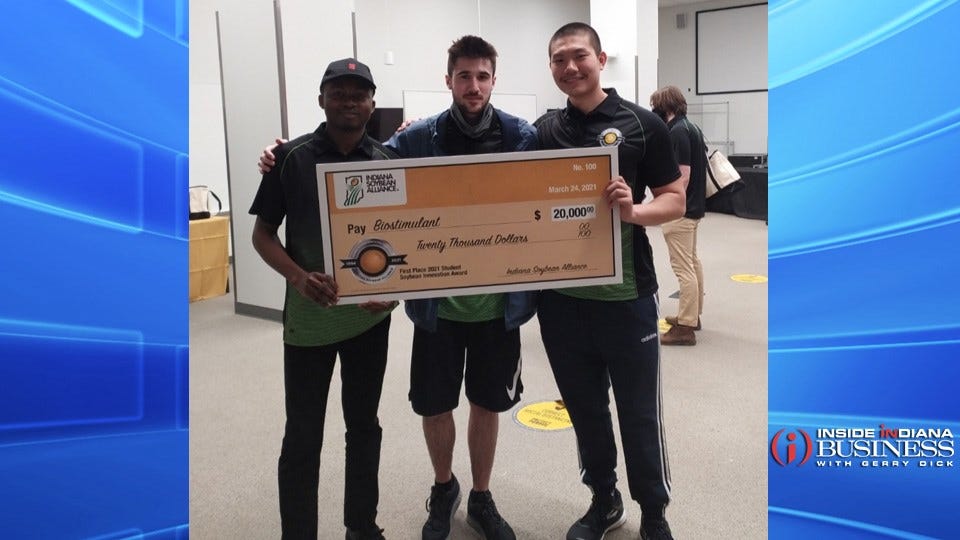Students’ Soy Biostimulant Claims Top Prize
 Alagbe
Alagbe
Subscriber Benefit
As a subscriber you can listen to articles at work, in the car, or while you work out. Subscribe Now“Lettuce prove it” could be the rally cry of a team of Purdue University students that just captured top prize at the annual Student Soybean Innovation Competition, where students harvest new ideas that will drive consumption of the crop. Now with a pending patent, the team invented a liquid biostimulant—made almost entirely of soybeans—that produced lettuce 30% bigger than standard lettuce when the students tested it. But greens are just the beginning; the team believes the biostimulant could be used on any plant, and especially benefit crops in vertical farming.
Vertical farming involves growing crops in vertically stacked layers, typically in a controlled environment such as a greenhouse. Common in urban areas, the rapidly growing industry aims to produce more crops in a smaller space.
“Our motivation [for the idea] came from looking at vertical farming and different ways to increase yield and biomass, because there’s a very quick turnaround in growing and selling in vertical farming,” says Purdue computer engineering student and team member Nate Nauman. “There’s, generally, very careful regulation of nutrient and water supply, which makes it really easy to add ingredients like a biostimulant with very specific concentrations.”
Purdue agribusiness student Cai Chen is the other undergraduate on the team. Emmanuel Alagbe, a Purdue animal sciences graduate student, says the team’s liquid biostimulant is composed of soy protein peptides.
“Peptides are long chains of amino acid,” says Alagbe. “Our soy biostimulant is made of peptides which have specific functions that help plants grow better. [The biostimulant] contains 98% soy product, so that was a plus on our side; this would direct the usage of soy into very effective ways of making money.”
Conventional fertilizers add nutrients like nitrogen or repel pests, but biostimulants use a different approach by stimulating the natural ability of plants to increase nutrient uptake and tolerate “abiotic stress,” such as temperature extremes or lack of water. The soy protein peptides in the team’s biostimulant also have natural antimicrobial and antibacterial properties. While the team says the biostimulant could be used on many plants, this characteristic is especially helpful for leafy greens, which are susceptible to contamination that cause foodborne illnesses.
“Our biostimulant is also biodegradable. We found that [one biostimulant] on the market is acidic, causing deficits in the soil when used over a long period of time, which is an environmental concern,” says Alagbe. “Another advantage is that our biostimulant would be relatively cheaper when produced on a large scale, compared to some of the other biostimulants we researched.”
The students’ innovation would capitalize on an area ripe for growth. Experts say the biostimulant industry, currently dominated by Europe, is expected to grow from $2.4 billion to $5.7 billion by 2026, with great potential in North America.
The Indiana Soybean Alliance (ISA) is now working to further develop the biostimulant and evaluate long-term feasibility and commercial potential; a patent application is currently being processed. The team is hopeful it could follow in the footsteps of previous winners, such as a student who developed soy candles—setting the standard for the now wildly popular product. It was ISA’s first major commercialized product, and the organization now holds six patents on soy wax in candles.
The competition awarded the second-place $10,000 prize to Team Sage 2.0, for making a soy-based, hypoallergenic athletic tape.
ISA and Purdue have created programs that encourage student inventors to remain involved as their ideas progress toward commercialization—taking advantage of two Hoosier commodities: soybeans and innovative Purdue students capable of sprouting big ideas from a humble bean.
Nauman says the team is awaiting the patent results, and then hopes to “expand the horizons of what our product can do.”
Alagbe says guidance from their advisor and their ability to work well as a team helped them claim top prize.
